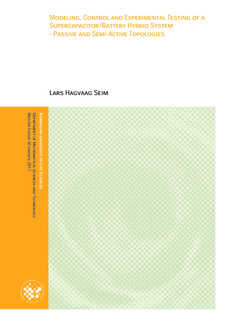| dc.contributor.author | Seim, Lars Hagvaag | |
| dc.date.accessioned | 2012-04-27T11:57:57Z | |
| dc.date.available | 2012-04-27T11:57:57Z | |
| dc.date.issued | 2012-04-27 | |
| dc.identifier.uri | http://hdl.handle.net/11250/188829 | |
| dc.description.abstract | Supercapacitors possess unique properties that can complement other energy storage technologies in hybrid electric energy systems. Due to its performance characteristics - such as fast charge and discharge capability, high power density and high recycleability - a supercapacitor
can relieve the battery of narrow and repeated transient charging and discharging, ensuring longer
battery life, enabling higher system peak power performance and improve system efficiency. An equivalent supercapacitor model is formalized based on electric characterization of two different supercapacitor modules(165 F and 130 F) manufactured by Maxwell Technologies.
A passive hybrid topology of a lead acid battery/supercapacitor configuration is analyzed, modeled and simulated using Matlab/Simulink, and then tested in the REHYS-laboratory at the Norwegian Institute of Energy Technology under a transient load regime using a pulse train load at different frequencies and
duty cycles. We find that the passive hybridization causes a significantly reduced battery current and voltage ripple, enhanced peak power performance and
potentially increased system efficiency and system run time, though, it is essential to minimize the parasitic resistances and inductances for optimal system performance. Greatest benefits are seen when the load pulse rate is higher than the system eigen-frequency and at smaller duty cycles. A semi-active topology applying a half-bridge, current controlled DC/DC-converter between supercapacitor and battery/load-side, is also analyzed, modeled
and simulated using Matlab/Simulink. Converter control design and control strategies is formulated using linear control theory and an average dynamic converter model. A moving average power smoothing control strategy is implemented, and simulations confirm that the
supercapacitor operation range is expanded and that the peak power performance is further enhanced when compared with the passive hybrid topology. | no_NO |
| dc.language.iso | eng | no_NO |
| dc.publisher | Norwegian University of Life Sciences, Ås | |
| dc.subject | engineering | no_NO |
| dc.subject | control methods | no_NO |
| dc.subject | models | no_NO |
| dc.subject | energy | no_NO |
| dc.subject | experiments | no_NO |
| dc.subject | testing | no_NO |
| dc.subject | power technology | no_NO |
| dc.subject | hybrid varieties | no_NO |
| dc.subject | renewable energy | no_NO |
| dc.subject | REHYS | no_NO |
| dc.subject | electric power | no_NO |
| dc.subject | Institute of Energy Technology | no_NO |
| dc.title | Modeling, control and experimental testing of a supercapacitor/battery hybrid system : passive and semi-active topologies | no_NO |
| dc.type | Master thesis | no_NO |
| dc.subject.nsi | Electrical power engineering: 542 | no_NO |
| dc.subject.nsi | Physics of condensed matter: 436 | no_NO |
| dc.subject.nsi | Mathematical modeling and numerical methods: 427 | no_NO |
| dc.subject.nsi | Simulation, visualization, signal processing, image processing: 429 | no_NO |
| dc.source.pagenumber | 147 | no_NO |
